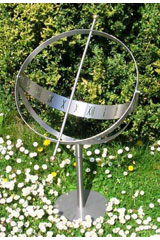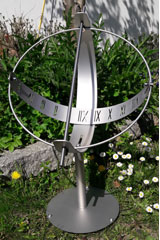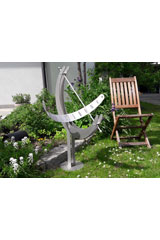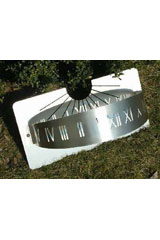Sundials
Sundials, an astronomical device for the garden
With us you can also get sundials of the highest quality. These Models are handmade in a small workshop in Germany and are simply unbeatable in terms of price and quality. The sundial is an astronomical device that sunlight and the current position of the sun can be used to the time of day. Until the 19th century people simply spoke of clocks when they meant sundials. One Sundial shows the time exactly. The shadow or the shadow The shadow direction of a body or rod indicates the time on the dial.
Sundials - Timepieces for the sunny side of life
Sundials are among the oldest timekeepers in human history. Among the numerous models that have developed significantly differentiated over time, the most popular types of sundals are still popular timepieces today - even for your own home or garden.
In general, the vertical sundials are mostly linear, flat surfaces that are attached to a wall or to a vertical bracket. The watch is then placed where the sun can hit it at a precisely calculated angle for most of the day. In the northern hemisphere of the Earth, this is the south wall of the building. Vertical sundials are the most common form, at least these days.
Horizontal sundials, as the name suggests, are horizontally oriented and are thus often installed on levels in the garden or in parks on unshaded areas. The clocks, which are now round, show the time throughout the day and do not have to be oriented to the south or the corresponding direction. These clocks only need to be placed flat on the ground at an exact angle to the earth's axis to ensure ideal legibility of the watch.
In addition to the well-known variants that display the time via a wandering shadow, there are also those sundials that work according to the same principle via a point of light. In this case, a shadow is cast on the dial via a pinhole, which is broken by a single hole. This hole only allows enough light to pass through the aperture to tell the time via a point of light that travels across the dial with the time of day.
In addition to the various styles, there are of course also different materials from which sundials are made. All these materials have one thing in common - the high weather resistance, which is necessary because these watches are intended for outdoor use. Stone sundials and metal sundials are the most common models that have proven themselves for a long time.
Choose your preferred payment
You can choose the following payments from our shop: PayPal, credit card and prepayment. For more information visit payment methods & FAQ More payments: prepayment with 3% off for wristwatches
INFORMATION
Last update 2024-05-13 10:30:08













